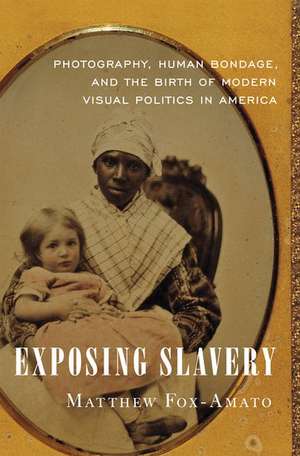Exposing Slavery: Photography, Human Bondage, and the Birth of Modern Visual Politics in America
Autor Matthew Fox-Amatoen Limba Engleză Hardback – 2 mai 2019
Preț: 258.29 lei
Preț vechi: 281.31 lei
-8% Nou
Puncte Express: 387
Preț estimativ în valută:
49.42€ • 51.73$ • 41.14£
49.42€ • 51.73$ • 41.14£
Carte disponibilă
Livrare economică 27 februarie-05 martie
Preluare comenzi: 021 569.72.76
Specificații
ISBN-13: 9780190663933
ISBN-10: 0190663936
Pagini: 360
Ilustrații: 105 color illustrations
Dimensiuni: 236 x 157 x 25 mm
Greutate: 0.82 kg
Editura: Oxford University Press
Colecția OUP USA
Locul publicării:New York, United States
ISBN-10: 0190663936
Pagini: 360
Ilustrații: 105 color illustrations
Dimensiuni: 236 x 157 x 25 mm
Greutate: 0.82 kg
Editura: Oxford University Press
Colecția OUP USA
Locul publicării:New York, United States
Recenzii
Lavishly illustrated, the book...urges historians to rethink the antebellum U.S. as a highly visual society in which people practiced, produced, and consumed photographic images. It similarly demands photo- and art-historians...rethink the political ramifications of early photography.... An original and compelling contribution to nineteenth-century American history, the book channels our view through the photographic lens, which shaped the self-understanding of a young nation approaching conflict.
Remarkable and pathbreaking...Fox-Amato's study of the photographic history of slaves and ex-slaves brilliantly assembles disparate bits of visual and textual evidence into telling insights about white American racial stereotypes and black resistance that reverberate into the present. His work shows how difficult it is to get at the truth of the slave experience, and how rewarding it is when the historical and visual detective work is done so thoroughly and effectively. The implications for our own time make reading this visual story difficult but looking away impossible.
An important contribution to the histories of slavery, abolition, visual culture politics, and photography. Moreover, the book's central argumentative thread shows how in the antebellum United States each of these domains were intertwined with the others in more subtle ways... than historians have previously appreciated. Scholars will rightfully be turning to these pages again and again for the important and under-remarked case studies that Fox-Amato brings to light through his deep and creative archival work....This research would be noteworthy on its own, even if it were not also paired in the book with deft storytelling, sensitive analysis, and a real dedication to seeing subtle stories in the materials.
Exposing Slavery gives some revealing insights on a somewhat overlooked aspect of ideological warfare.
Exposing Slavery is a significant contribution to 19th and 20th -century visual studies examining the relationship between race, representation, and photography. Fox-Amato's book is meticulous research that is well organized and cohesive, managing to cover a great number of themes.
Exposing Slavery deserves rich praise for casting light on the role that photography played in the institution of slavery, and how various agents adopted the photographic lens as a way of identifying themselves and others in line with their ideological perceptions. Fox-Amato engages with an archive that, despite its silences, is richly fleshed out in this text. By unearthing new materials and offering a new framework through which to consider these images and texts, Exposing Slavery will inspire discussion on the nature of photography in the nineteenth century for some time to come.
original, richly illustrated, and brilliant book
Remarkable and pathbreaking...Fox-Amato's study of the photographic history of slaves and ex-slaves brilliantly assembles disparate bits of visual and textual evidence into telling insights about white American racial stereotypes and black resistance that reverberate into the present. His work shows how difficult it is to get at the truth of the slave experience, and how rewarding it is when the historical and visual detective work is done so thoroughly and effectively. The implications for our own time make reading this visual story difficult but looking away impossible.
An important contribution to the histories of slavery, abolition, visual culture politics, and photography. Moreover, the book's central argumentative thread shows how in the antebellum United States each of these domains were intertwined with the others in more subtle ways... than historians have previously appreciated. Scholars will rightfully be turning to these pages again and again for the important and under-remarked case studies that Fox-Amato brings to light through his deep and creative archival work....This research would be noteworthy on its own, even if it were not also paired in the book with deft storytelling, sensitive analysis, and a real dedication to seeing subtle stories in the materials.
Exposing Slavery gives some revealing insights on a somewhat overlooked aspect of ideological warfare.
Exposing Slavery is a significant contribution to 19th and 20th -century visual studies examining the relationship between race, representation, and photography. Fox-Amato's book is meticulous research that is well organized and cohesive, managing to cover a great number of themes.
Exposing Slavery deserves rich praise for casting light on the role that photography played in the institution of slavery, and how various agents adopted the photographic lens as a way of identifying themselves and others in line with their ideological perceptions. Fox-Amato engages with an archive that, despite its silences, is richly fleshed out in this text. By unearthing new materials and offering a new framework through which to consider these images and texts, Exposing Slavery will inspire discussion on the nature of photography in the nineteenth century for some time to come.
original, richly illustrated, and brilliant book
Notă biografică
Matthew Fox-Amato is Assistant Professor of History at the University of Idaho. He is a historian of visual and material culture.
